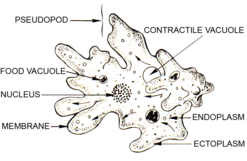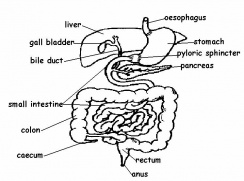User:Priyanka manpreet/Sandbox
===Nutrition in animals===
Animal nutrition covers nutrient requirements, how the food is consumed, and how the body utilizes the food. Digestion is process that converts complex food substances to simpler ones. Nutrition involves the following:
Ingestion, Digestion, Absorption, Assimilation, and Egestion
__TOC 1.Nutrition in Animals 2.Mode of nutrition 3.Digestion in amoeba 4.Human digestive system 5.Mouth__
Contents
Herbivores
These animals fed on plants and plant products for their survival. Example: Deer, Rabbit, Cow
Carnivores
feed on animal meet
Predators: Chase and kill prey to eat.
Example: Lion, Cheeta, Tiger
Scavengers: consume dead and rotten meat
Example: Vultures, Jackals
Omnivores
These animals eat both plants and animals. Example: Crows, Humans
Parasites
These animals feeds or benefits from another organism, the host and can cause it harm. Example: Mosquito, Tapeworm
Decomposers
Feed on dead plants and animals and decompose them. Example: Bacteria
Digestion in Amoeba
The modes of nutrition is Amoeba is holozoic. The process of obtaining food is called phagocytosis. Amoeba is a unicellular organism, which feeds on plankton, bacteria, microscopic algae and small unicellular organisms. It uses any part of its body to capture its food.
1. When it senses foods in its surroundings. It extends its pseudopodia in that direction and moves towards it. 2. Then it engulfs the food with its pseudopodia. 3. When the food enters its body the amoeba forms food vacuole around it which contains certain enzymes to digest the food. 4. When the food is digested the unwanted waste is released through its body surface.
The Digestive System
Digestion is the process of breaking down of complex food into simpler form, in order to absorb nutrients
Most of the food we eat is in insoluble form. The food has to undergo 5 stages of processing, in order to absorb nutrients from the food.
1. Ingestion- Intake of food from various sources in the environment. 2. Digestion- The breaking down complex food into soluble form by the action of digestive juices and enzymes. 3. Absorption- The passing of soluble simple food into the blood stream of the animal. 4. Assimilation- The food molecules carried by blood are absorbed by our body cell. 5. Egestion- The process through which undigested food is thrown out of the body.
The digestive system consist of hollow organs: mouth, esophagus, stomach, small intestine, large intestine, rectum, anus. These are joined together in a long tube called alimentary canal. Accessory organs also help in digestion such as liver and pancreas.
Mouth
Food begins its journey through the digestive system in the mouth, also known as the oral cavity. Inside the mouth are many accessory organs that aid in the digestion of food—the tongue, teeth, and salivary glands. Teeth chop food into small pieces, which are moistened by saliva before the tongue and other muscles push the food into the pharynx.Oral cavity, cross-section
Teeth. The teeth are 32 small, hard organs found along the anterior and lateral edges of the mouth. Each tooth is made of a bone-like substance called dentin and covered in a layer of enamel—the hardest substance in the body. Teeth are living organs and contain blood vessels and nerves under the dentin in a soft region known as the pulp. The teeth are designed for cutting and grinding food into smaller pieces.
Tongue. The tongue is located on the inferior portion of the mouth just posterior and medial to the teeth. It is a small organ made up of several pairs of muscles covered in a thin, bumpy, skin-like layer. The outside of the tongue contains many rough papillae for gripping food as it is moved by the tongue’s muscles. The taste buds on the surface of the tongue detect taste molecules in food and connect to nerves in the tongue to send taste information to the brain. The tongue also helps to push food toward the posterior part of the mouth for swallowing.
Salivary Glands. Surrounding the mouth are 3 sets of salivary glands. The salivary glands are accessory organs that produce a watery secretion known as saliva. Saliva helps to moisten food and begins the digestion of carbohydrates. The body also uses saliva to lubricate food as it passes through the mouth, pharynx, and esophagus.

